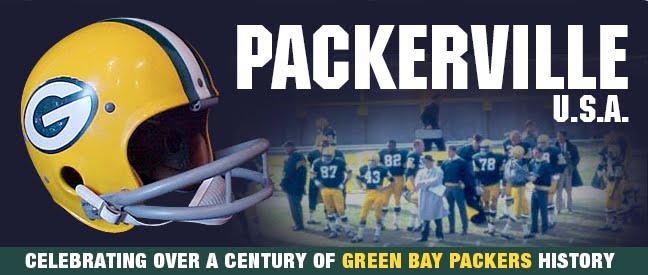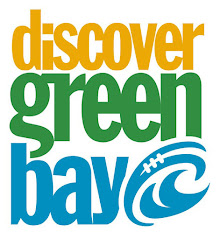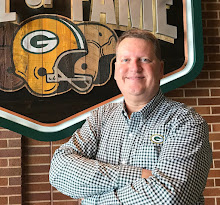
Today’s posting is the Milwaukee Journal’s coverage of the final game in Milwaukee County Stadium on December 18, 1994. The following season, all Packers’ home games were played in Green Bay, as they have been ever since. I attended the game with my brother, and Favre’s winning dive was right in our corner of the end zone...
Packers soar on Favre's flight
Milwaukee finale ends in heroic dive
By BOB McGINN, The Milwaukee Journal
Dec. 19, 1994
The Green Bay Packers endured an entire season of blown opportunities to finally pull out a close game at the end.
They also waited 20 years to find a worthy successor to Bart Starr as their quarterback.
Brett Favre stamped himself indelibly in the memories of the loyal fans of Milwaukee on Sunday with the Packers' most memorable play of the season seemingly headed for oblivion.
With one damn-the-torpedoes, full-speed-ahead dash to either destruction or glory, Favre saved the season with a diving exclamation point in a 21-17 victory over the Atlanta Falcons in the Packers' final game ever at County Stadium.
"It's vintage Brett Favre," kicker Chris Jacke said. "Dumb and brilliant at the same time. If he doesn't make the first down or get out of bounds, we'd have been in trouble."
By outrunning defensive end Chuck Smith to the corner and hurling his body across the goal-line for the 9-yard touchdown with 14 seconds remaining, Favre climaxed a decisive 10-play, 67-yard drive.
But had he failed and been tackled in-bounds on his third-and-two scramble, the Packers might not have been able to reassemble, snap the ball and stop the clock because they were out of timeouts.
And, if Favre had been tackled short of the first down, the field-goal team would have had to make an improbable rush into position for a hurried attempt.
"I yelled to Brett to get out of bounds," Jacke said. "But I guess you just have to live and die with the kid."
When Atlanta's Hail Mary pass fell incomplete as time expired, the crowd of 54,885 stood as one in a final show of support after 62 years of watching the Packers.
As he approached the dugout tunnel, Packers coach Mike Holmgren paused near a snowbank along the first-base line and saluted the crowd. It was perhaps the most emotional post-game scene since the final home game of 1981, when Starr gathered his team at midfield in Lambeau Field after a victory over Detroit and sent them scattering to all corners of the stadium to shake hands with the fans.
"I'll never forget this," Holmgren said. "It was a very special moment. Just a wonderful game."
Nothing was wonderful for the Packers after their two-touchdown start created a false sense of superiority. From the start of the second quarter until 2 minutes remained, the Packers turned a 14-3 lead into a 17-14 deficit by failing to score on seven consecutive possessions.
The loss of Sterling Sharpe with a spinal injury in the second quarter cost the Packers their premier weapon. But before Sharpe left, he dropped a third-down pass that started the offensive malaise.
Later, Jacke would push wide to the right field-goal tries from 51 and 37 yards. Favre would throw an interception in the end zone after guard Harry Galbreath allowed excessive penetration by defensive tackle Jumpy Geathers.
Holding penalties on Guy McIntyre, Reggie Johnson and Galbreath would ruin two third-quarter drives. Then two fourth-quarter possessions would go no-where when the Falcons' 28th-ranked defense began to sense an upset.
"I was surprised our offense didn't do more today," Packers tackle Ken Ruettgers said. "Hopefully, it's just a fluke."
Atlanta got the ball back with 4 minutes 41 seconds left and a three-point cushion. The Falcons managed one-first down, then faced third and four when the Packers called their second of three timeouts. Just 2:10 remained.
Atlanta coach June Jones sent three wide receivers to the right and isolated Andre Rison against Doug Evans on the left. Just four plays earlier, Evans had gotten away with an obvious interference penalty, and on the previous series Rison had burned him for 25-yard gain and then the two-point conversion.
Rison drove hard against Evans, broke off his route and went to the sideline.
"He wanted me to to go up the field," Evans said.
But Evans stayed with Rison, giving backup quarterback Bobby Hebert little margin on the throw. Hebert made a bad pass, which was wide of Rison. Harold Alexander's 31-yard punt left the Packers to start from their 33 with 1:58 left.
"We didn't want to force it in there," Hebert said. "If we had made one more first down we would have been in pretty good shape."
The tone for the entire drive was set on the first play when tight end Mark Chmura ran scot-free down the middle of the field and made a stumbling catch for 25 yards. The Falcons double-covered the two wide receivers, leaving linebacker Jessie Tuggle to cover Chmura. But Tuggle moved up to cover Edgar Bennett, leaving Chmura open.
Chmura dropped a 13-yard pass on the next play, stopping the clock at 1:33. The Packers ran the same play and Favre found Robert Brooks for three. With the clock running, Favre hesitated and drilled an out pass to Brooks for 10 yards and the first down.
"I threw it as hard as I've thrown one all day and Robert made a great catch and stepped out," Favre said.
At that point, the Falcons changed from a 4-1 to 4-3 defense, but the Packers stayed in their base offense. Favre wisely threw incomplete to Bennett, then called an audible against a blitz and found the diving Anthony Morgan for four yards. With the clock again running, Brooks caught a short crossing pass from Favre and swung upfield with a gutsy cut to gain the first down by about a yard at the 17.
A spike killed the clock with 19 seconds left. The Falcons then went into a zone defense, so Favre went to Chmura underneath for eight yards to the 9.
"Brett just kept making great decisions," Packers wide receivers coach Jon Gruden said. "The Falcons didn't take a lot of risks and he executed perfectly. He was just composed."
Holmgren sent out three wide receivers for the first time in the drive, Terry Mickens and Morgan tight on the left and Brooks on the right. The Packers sent five receivers in the pattern, with Mickens on a short crossing route from left to right. Brooks on a deep post pattern, Chmura working into the middle of the end zone, and Morgan and Bennett occupying defenders on the short left.
"It's an all-purpose play against any defense," Gruden said.
As Favre took a five-step drop, right tackle Joe Sims was being bull-rushed by Smith. It was a gamble by Smith, because if he got sucked inside there was no one to contain Favre if he scrambled right.
"Usually, he was coming up the field," Sims said about Smith. "But the [pain-killing] shot I took before the game had started to wear off. I think he saw me limping and he tried to bowl me over."
As Smith pushed Sims backward, Geathers broke free inside with his patented "forklift" power move against Galbreath. As Favre bounced right, Sims noticed him in his peripheral vision. He shuffled his feet and hooked Smith, which was crucial to the success of the play.
Smith didn't totally blow containment. He pushed off Sims and, on a normal day with his outstanding speed, probably would have been quick enough to prevent Favre from turning the corner.
But remember that Smith suffered a sprained knee in the second quarter and thereafter had been in and out of the lineup. So when their paths intersected at the 9, the best Smith could do was dive at Favre's heels.
Favre stumbled at the 6, gathered himself at the 3 and lunged in the air. He landed just across the goal line, safely under the charge of the big rookie cornerback, Anthony Phillips.
"It could have been another [Jay] Novacek," said Morgan, a reference to the Cowboys' tight end who was tackled at the 6-inch line as time expired in Cleveland's 19-14 victory last week.
"Hey, we have to get lucky one of these days," Sims said. "Brett's not the perfect guy, but he's such a winner."























































